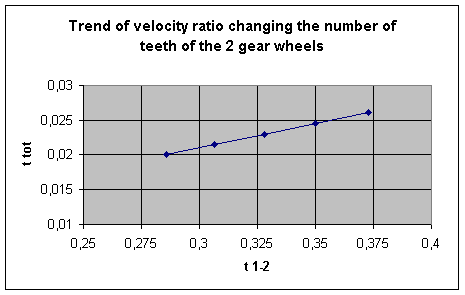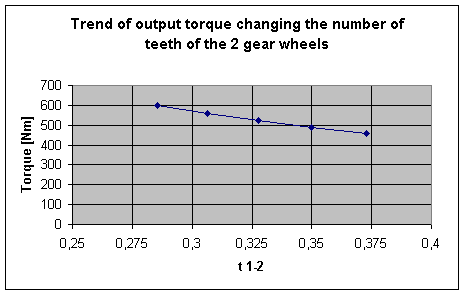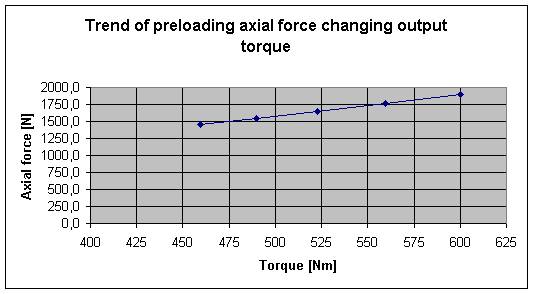
It is possible to parametrize only two gear wheels, number 293270 and 293310, two annular gear wheels with straight teeth which directly mate, because of the following reasons:
- the measures of the box cannot be changed;
- the parts constituting the whole reduction gear have been designed and assembled to minimize the overall dimension.
The
first gear wheel is characterized by these data:
- module
= 3
- number
of teeth = 18
-
reference rack = UNI 6587-69
- pitch
diameter = 54
-
pressure angle = 20°
The
torque passes from the first to the second gear wheel, featured by:
- module
= 3
- number
of teeth = 63
-
reference rack = UNI 6587-69
- pitch
diameter = 189
-
pressure angle = 20°
On the
same shaft there are two other helical gear wheels, one right handed, the other
left handed, so that the forces are counterbalanced and so that there is a
constraint for the shaft on which these two gear wheels are fit - otherwise the
shaft would move towards the bottom of the box-. Each of these last two gear
wheels mates with another gear wheel fit on the two output shafts.
The
parametrization must leave the wheel base unchanged = 121,5mm.
In other
words, the sum of the teeth belonging to the two gear wheels must be constant =
81 teeth.
Analysing
the free spaces and the dimensions of the other near objects in the assembly, we
can observe the velocity ratio and the output torque change while changing the
number of teeth 4 times:
|
|
z1 |
z2 |
m |
d1 [mm] |
d2 [mm] |
t 1-2 |
t tot |
C
output [Nm] |
|
Project data |
18 |
63 |
3 |
54 |
189 |
0,2857 |
0,02 |
600 |
|
1 |
19 |
62 |
3 |
57 |
186 |
0,3065 |
0,0215 |
559,40 |
|
2 |
20 |
61 |
3 |
60 |
183 |
0,3279 |
0,0230 |
522,86 |
|
3 |
21 |
60 |
3 |
63 |
180 |
0,3500 |
0,0245 |
489,80 |
|
4 |
22 |
59 |
3 |
66 |
177 |
0,3729 |
0,0261 |
459,74 |
z = teeth number of the gear wheel
m = module
d = pitch diameter of the gear wheel
d = z*m
t= velocity ratio
t 1-2 = z1/z2
t tot = Pt i
= 1/50
C = output
torque
C = C input / ttot
C input
= 12 Nm

Increasing
the number of teeth of the first gear wheel and reducing that of the driven one,
the velocity ratio increases.

Consequently
the output torque available at the output shafts decreases. Together with the
torque, the preloading axial force decreases, and this is due to the tangential
force on the output pigno
n, which lessens.
|
|
C |
F
tg |
F
max |
F
tg p |
C
p |
F
tg pign |
F ax
prec |
|
Project
data |
600 |
11905,0 |
14881,2 |
5952,5 |
300 |
2911,5 |
1891,0 |
|
1 |
559 |
11099,4 |
13874,3 |
5549,7 |
280 |
2714,5 |
1763,0 |
|
2 |
523 |
10374,4 |
12968,0 |
5187,2 |
261 |
2537,2 |
1647,9 |
|
3 |
490 |
9718,4 |
12148,1 |
4859,2 |
245 |
2376,7 |
1543,7 |
|
4 |
460 |
9122,0 |
11402,5 |
4561,0 |
230 |
2230,9 |
1448,9 |
C = output torque
F tg = nominal axial force on output pignon
F max = maximum tangential force on pignon, found multiplying
the nominal axial force by a safety factor
F tg p = preloading tangential force on pignon, equal to 40%
of maximum tangential force
C p = preloading torque on output pignon shaft
F tg prel = tangential force on double preloading output
helical pignon
F ax = preloading axial force
Necessary formula for the computations:
F tg = C / (d/2)
F max = 1,25* F tg
F tg p = 0,4* F max
C p = F tg p *d/2
F tg prel = [C p *(z2/z1)]/(dp/2)
F ax = 2* F tg prel tgb
Symbols:
d = pitch diameter of output pignon = 100,798mm
dp = pitch diameter of helical preloading pignon = 77,28mm
z1 = number of teeth of annual gear 293340 = 56
z2 = number of teeth of preloading helical pignon 293330 = 21
b
= rake of preloading helical pignon = 18°
Forces
are expressed in N and torques in Nm.

On the
one hand, a further increase of the first gear wheel number of teeth could be
interesting for the further reduction of the velocity ratio, and the dimensions
of the two parts would be compatible with the other parts in the assembly. On
the other hand, this would mean a further reduction of the output torque, while
a machine tool requires a certain value of available torque, which allows better
finish turning, higher chip thickness,...
Also the
output helical gears should be parametrized, but this would mean increasing
their number of teeth (decreasing is not compatible with the geometry of the
box), which would mean a further reduction of the output torque.